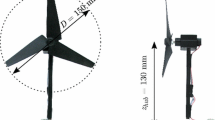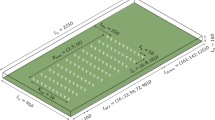Abstract
Increasing demand in wind energy has resulted in increasingly clustered wind farms, and raised the interest in wake research dramatically in the last couple of years. To this end, the present work employs an experimental approach with scaled three-bladed wind-turbine models in a large boundary-layer wind-tunnel. Time-resolved measurements are carried out with a three-component hot-wire anemometer in the mid-vertical plane of the wake up to a downstream distance of eleven turbine diameters. The major issue addressed is the wake dynamics i.e. the flow and turbulence characteristics as well as spectral content under two different neutral boundary-layer inflow conditions. The wind tunnel is arranged with and without roughened surfaces in order to mimic moderately rough and smooth conditions. The inflow characterization is carried out by using all three velocity components, while the rest of the study is focused on the streamwise component’s evolution. The results show an earlier wake recovery, i.e. the velocity deficit due to the turbine is less persistent for the rough case due to higher incoming turbulence levels. This paves the way for enhanced mixing from higher momentum regions of the boundary layer towards the centre of the wake. The investigation on the turbulent shear stresses is in line with this observation as well. Moreover, common as well as distinguishing features of the turbulent-scales evolution are detected for rough and smooth inflow boundary-layer conditions. Wake meandering disappears for rough inflow conditions but persists for smooth case with a Strouhal number similar to that of a solid disk wake.

















Similar content being viewed by others
References
Ainslie J (1988) Calculating the flowfield in the wake of wind turbines. J Wind Eng Ind Aerodyn 27:213–224
Bastankhah M, Porte-Agel F (2014) A new analytical model for wind-turbine wakes. Renew Energy 70:116–123
Bingol F, Mann J, Larsen GC (2010) Light detection and ranging measurements of wake dynamics. Part 1: one-dimensional scanning. Wind Energy 13:51–61
Bossuyt J (2013) Study of wind farm layout via wind tunnel testing. M.Sc. Thesis, KU Leuven
Chamorro LP, Porte-Agel F (2009) A wind-tunnel investigation of wind-turbine wakes: boundary-layer turbulence effects. Boundary-Layer Meteorol 132:129–149
Chamorro LP, Arndt REA, Sotiropoulos F (2012) Reynolds number dependence of turbulence statistics in the wake of wind turbines. Wind Energy 15:733–742
Chamorro LP, Guala M, Arndt REA, Sotiropoulos F (2012) On the evolution of turbulent scales in the wake of a wind turbine model. J Turbul 13:N27
Cheung JCK, Melbourne WH (1983) Turbulence effects on some aerodynamic parameters of a circular-cylinder at supercritical reynolds-numbers. J Wind Eng Ind Aerodyn 14(1–3):399–410
Conan B (2012) Wind resource assessment in complex terrain by wind tunnel modelling. Ph.D. Thesis, VKI and Univesite d’Orleans
Counihan J (1975) Adiabatic atmospheric boundary layers: a review and analysis of data from the period 1880–1972. Atmos Environ 9:871–905
Crespo A, Hernandez J, Frandsen S (1999) Survey of modelling methods for wind turbine wakes and wind farms. Wind Energy 2:1–24
Devinant P, Espana G, Loyer S, Aubrun S (2011) Spatial study of the wake meandering using modelled wind turbines in a wind tunnel. Wind Energy 14(7):923–937
Fruytier PA (1993) Conception, experimentation, ameloration dun logiciel mde mesure anemomtrique tridimensionalles pour des sondes a trois fils chauds. M.Sc. Thesis, U-VKI
Gaumond M, Rethore P-E, Bechmann A, Ott S, Larsen GC, Pena Diaz A, Hansen K S (2012) Benchmarking of wind turbine wake models in large offshore wind farms. Poster at The Science of Making Torque from Wind 2012, Oldenburg
Larsen GC, Aa Madsen H, Thomsen K, Larsen TJ (2008) Wake meandering: a pragmatic approach. Wind Energy 11(4):377–395
Maull DJ, Young RA (1973) Vortex shedding from bluff bodies in a shear flow. J Fluid Mech 60(2):401–409
Medici D, Alfredsson PH (2006) Measurements on a wind turbine wake: 3D effects and bluff body vortex shedding. Wind Energy 9(3):219–236
Newman J, Lebron J, Meneveau C, Castillo L (2013) Stream-wise development of the wind turbine boundary layer over a model wind turbine array. J Phys 25:8
Rados KG, Prospathopoulos JM, Stefanatos NC, Politis ES, Chaviaropoulos PK, Zervos A (2009) CFD modeling issues of wind turbine wakes under stable atmospheric conditions. Poster Session EWEC
Sanderse B, van der Pijl SP, Koren B (2011) Review of computational fluid dynamics for wind turbine wake aerodynamics. Wind Energy 147:799–819
Zhang W, Markfort CD, Porte-Agel F (2013) Wind-turbine wakes in a convective Boundary-Layer: a wind-tunnel study. Boundary-Layer Meteorol 146(2):161–179
Author information
Authors and Affiliations
Corresponding author
Rights and permissions
About this article
Cite this article
Barlas, E., Buckingham, S. & van Beeck, J. Roughness Effects on Wind-Turbine Wake Dynamics in a Boundary-Layer Wind Tunnel. Boundary-Layer Meteorol 158, 27–42 (2016). https://doi.org/10.1007/s10546-015-0083-z
Received:
Accepted:
Published:
Issue Date:
DOI: https://doi.org/10.1007/s10546-015-0083-z




